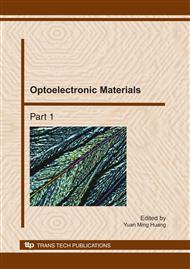[1]
D. -K. Yang, J. L. West, L. -C. Chien and J. W. Doane: J. Appl. Phys. Vol. 76 (1994), p.1331.
Google Scholar
[2]
D. -K Yang, J. W. Doane, Z. Yaniv and J. Glasser: Appl. Phys. Lett. Vol. 64 (1994), p. (1905).
Google Scholar
[3]
Y. M. Huang and Q. –L Ma: Cryst. Liq. Cryst. 2010 (in press).
Google Scholar
[4]
Y. M. Huang and B. -G. Zhai: Mol. Cryst. Liq. Cryst. Vol. 511 (2009), p.337.
Google Scholar
[5]
Y. M. Huang and B. -G. Zhai: Mol. Cryst. Liq. Cryst. Vol. 510 (2009), p.34.
Google Scholar
[6]
Q. –L Ma and Y. M. Huang: Key Eng. Mater. Vols. 428-429 (2010), p.228.
Google Scholar
[7]
Y. M. Huang, Y. -T Guo, Q. -L. Ma and W. -W. Liu: Key Eng. Mater. Vols. 428-429 (2010), p.94.
Google Scholar
[8]
M. Perez-Mendez, R. Marsal-Berenguel and S. Sanchez-Cortes: Adv. Mat. Vol. 58 (2004), p.562.
Google Scholar
[9]
J. Ma, Y. N. Xuan and Y. M. Huang: Chin. Chem. Letters Vol. 16 (2005), p.127.
Google Scholar
[10]
Y. M. Huang, F. –F. Zhou and B. –G. Zhai: Acta Optica Sinica Vol. 29 (2009).
Google Scholar
[1]
(If square brackets are not available, slashes may be used instead, e. g. /2/. ) Two or more references at a time may be put in one set of brackets [3, 4]. The references are to be numbered in the order in which they are cited in the text and are to be listed at the end of the contribution under a heading References, see our example below. This work was financially supported by the following funds: (1) the Natural Science Foundation of China (No. 10674091); (2) the Scientific Research Fund for Returned Overseas Chinese Scholar from Education Ministry of China (No. 2005-546); (3) Key Research Project of the Education Ministry of China (No. 206110); (4) the 11th Young Scientist Program of Yunnan Province (No. 2008PY058); and (5) the Natural Science Foundation of Yunnan Province (No. 2008CD110). Summary On your CD, please indicate the format and word processor used. Please also provide your phone number, fax number and e-mail address for rapid communication with the publisher. Please always send your CD along with a hard copy that must match the CD's content exactly. If you follow the foregoing, your paper will conform to the requirements of the publisher and facilitate a problem-free publication process. References.
Google Scholar
[1]
Dj.M. Maric, P.F. Meier and S.K. Estreicher: Mater. Sci. Forum Vol. 83-87 (1992), p.119.
Google Scholar
[2]
M.A. Green: High Efficiency Silicon Solar Cells (Trans Tech Publications, Switzerland 1987).
Google Scholar
[3]
Y. Mishing, in: Diffusion Processes in Advanced Technological Materials, edtied by D. Gupta Noyes Publications/William Andrew Publising, Norwich, NY (2004), in press.
Google Scholar
[4]
G. Henkelman, G. Johannesson and H. Jónsson, in: Theoretical Methods in Condencsed Phase Chemistry, edited by S.D. Schwartz, volume 5 of Progress in Theoretical Chemistry and Physics, chapter, 10, Kluwer Academic Publishers (2000).
Google Scholar
[5]
R.J. Ong, J.T. Dawley and P.G. Clem: submitted to Journal of Materials Research (2003).
Google Scholar
[6]
P.G. Clem, M. Rodriguez, J.A. Voigt and C.S. Ashley, U.S. Patent 6, 231, 666. (2001).
Google Scholar
[7]
Information on http: /www. weld. labs. gov. cn D. Vorlander: A. Apel, Ber. Dtsch. Chem. Ges., Vol. 62 (1929), p.2831.
Google Scholar
[2]
G. Pelzl, I. Wirth and W. Weissflog: Liq. Cryst., Vol. 28 (2001), p.969.
Google Scholar
[3]
T. Niori, T. Sekine, J. Watanabe, T. Furukawa and H. Takezoe: J. Mater. Chem., Vol. 6 (1996), p.1231.
Google Scholar
[4]
G. Pelzl, S. Diele and W. Weissflog: Adv. Mater., Vol. 11 (1999), p.707.
Google Scholar
[5]
D. M. Walba, E. Korblova, R. Shao, J. M. Maclennan, D. R. Link, M. A. Glaser and N. A. Clark: Science, Vol. 288 (2000), p.2181.
Google Scholar
[6]
Y. M. Huang and B. G. Zhai: Mol. Cryst. Liq. Cryst. (in press).
Google Scholar
[7]
Y. M. Huang and B. G. Zhai: Mol. Cryst. Liq. Cryst. (in press).
Google Scholar


